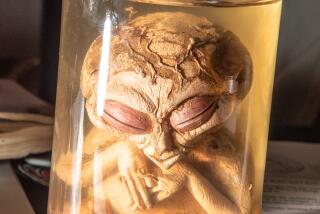Jumpin’ Jupiter--Is This the End of the World? : Astronomy: We may not see much of the action when the comet hits Jove’s dark side, but that hasn’t stopped the hard-core looky-loos and talk of Doomsday.
Planetary bombardment can be a humbling experience.
Virtually unnoticed between the Three Tenors concert on Saturday and O.J. Simpson’s scheduled arraignment on July 22, a chorus of comets will pummel Jupiter with the force of a million H-bombs.
And so, you’re probably wondering: What’s in it for me?
If you’re an astronomer, it will be a once-in-a-lifetime chance to glimpse the kind of cataclysm that might have wiped out the dinosaurs and paved the way for human life.
But for the scores of interstellar looky-loos hoping for a piece of the cosmic action, it may be a disappointment. For sheer entertainment value, say several veteran astronomers, the Home Shopping Network may be more promising.
“It will be about as spectacular as pricking an apple with a needle,” said Gibson Reaves, USC astronomy professor emeritus.
Despite this dour forecast--one shared by the majority of serious stargazers--a bustling comet subculture has burgeoned in recent months. It’s like some surreal cafe in the deep backwaters of space where Internet junkies meet religious mystics, armchair space travelers shake hands with their sci-fi heroes and an 11-year-old boy convinces a South Dakota community that doom is not at hand.
These people don’t want to know the odds, that the chances of catching the fury of the Shoemaker-Levy 9 comet are indeed dim.
Jupiter, while not quite billions and billions of miles from Earth, is hardly a weekend drive away. The comet will hit Jove’s dark side, out of the sight of even the mighty Hubble Space Telescope. To catch a live shot, earthbound astronomers must rely on the odd chance that a fireball will reflect off one of Jupiter’s moons. And because of a faulty antenna, the Galileo space probe, which is in a perfect spot to view the festivities, will not transmit pictures of the 5 1/2-day crash until August, at the earliest.
Furthermore, some data suggest that the 20-odd cometary fragments may break up before impact with Jupiter’s turbulent atmosphere. By that time, some scientists say, the comets could be reduced to celestial dust bunnies.
But that hasn’t stopped people “who know the situation” from buying telescopes in droves, said Nick Patel of Scope City in Costa Mesa. And John Mosley, a Griffith Observatory astronomer, continues to be bombarded by strange questions.
“Someone asked me today what kind of eye protection he should wear,” Mosley said. “People have asked what kind of telescope filter should they use. Those people are off by some 30 orders of magnitude.”
For non-scientists, that’s “about a godzillian.”
The electronic superhighway has been jammed with pet theories about the event as well as invitations to comet parties around the globe. As one traveler, identified only as “Mingtoy,” explained: “It would be pretty cool if something spectacular happened out there in my lifetime. I’m not getting any younger.”
Like a seduction scene from a 1940s movie, the thrill for many comet-watchers lies in what’s left to the imagination.
Few people understand that as well as Larry Niven, the science fiction legend whose “Lucifer’s Hammer” has become a focal point for discussion in recent weeks.
In that novel, co-written by Jerry Pournelle, Niven envisioned an Earth under attack from comets hurtling through space. Now, like scores of amateur astronomers watching Shoemaker-Levy, Niven is thinking in “what ifs.” What if, for instance, the comet is not a string of 20 fragments, but one chunk the size of a moon?
It would, he muses, fire the planet to an unimaginable temperature, emitting enough heat to warm one of Jupiter’s moons and possibly facilitate human life.
“I can picture it,” he said. “A colony on a moon of red-hot Jupiter, so visually arresting with that great big, gaudy red thing flying around. Your grandmother could literally float in the gravitational pull of (the moon) Ganymede. Give her swimming fins and a hang glider and she could do it.”
He added: “I am much too busy to write such a book, but its a neatsy idea.”
Here on the home planet, the Jupiter rendezvous has caused some very real Angst in the ultra-orthodox Lubavitch community, still reeling from the death last month of its New York City spiritual leader, Rebbe Menachem Mendel Schneerson.
Believing the rebbe to be the Messiah, many followers have eagerly embraced stories linking the comet to an obscure medieval prophecy in the Zohar, a book of Jewish mysticism.
They believe the work says that the coming of the Messiah will be presaged by a bombardment of Jupiter. A tract refers to a “cosmic pillar” of fire hitting an eastern planet “shining in all its colors,” which will announce the savior’s arrival. And to be sure, the cometary bombardments on July 21 will mark 40 days since Schneerson’s death--the 40 days after which, according to messianic lore, the savior will rise from the dead.
Even if one accepts the validity of the Zohar, said Judaic studies professor Elliot Wolfson of New York University, “it’s a stretch.”
Although Zohar references were noticeably absent from the weekly taped message on the sect’s toll-free Messiah hot line--(800) 4-MOSHIACH--Rabbi Yosef Mishulovin of Los Angeles acknowledged that the prophecy has prompted “a lot of talk.” His own feelings are ambivalent: “If it happens, it happens.”
Of course, when great things happen in space, fantasy and reality often mingle.
For Ted Daniels, the event has been a virtual field day. As curator of “Millenium Watch,” a clearinghouse of revelation and news of the weird, Daniels has been flooded with comet-related stories. Predictions range from Judgment Day doom to harmonic convergence. But the jewel came from Paul Shockley, who wrote to Daniels’ quarterly newsletter from Olympia, Wash.
The comet crash, Shockley writes, is really a cover-up for the detonation aboard the Galileo of a plutonium bomb, which would turn Jupiter into another sun. What look to be comets, he continues, are really alien ships intent on monkeying with the Hubble Space Telescope.
“Oh, I see,” Daniels said, as he finished the letter. “It’s a preemptive strike in a space war.”
In some corners of the world, such news is not taken lightly. Take, for example, the following report on America On-Line from a South Dakota Indian reservation with limited access to news.
An alarmed writer, identified only as “Wolfmed,” said: “Students came into class and claimed that an asteroid was going to impact with Jupiter and destroy the Earth.”
Enlightenment came in the form of one Marshall Fowler, who described himself as “a fifth-grade student at Abel Elementary School in Sarasota, Fla.” Reports of the Earth’s demise, he said, were premature.
“I don’t believe there is anything to worry about,” he said. “It hasn’t even been in the media.”
*
Times research librarian Lonny Brooks contributed to this report.


